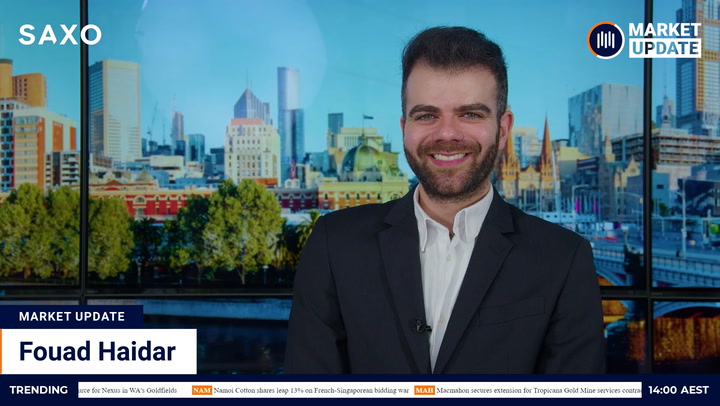Aside from a few exceptions, commodities have had two consolidation years with mostly sideways movements.
But gold’s already shining, and some say the signs are there that other commodities are also about to take a run.
Saxo Head of Commodity Strategy, Ole Hansen, said there were signals suggesting a recovery from this quarter, buoyed by potential central bank rate cuts, which could soften the US dollar and reduce funding costs.
In particular, the poor performance of natural gas could be set to alleviate this quarter, gold – which is trading at record highs – could keep rising, along with silver and copper, and, grains may also rebound.
The sentiment came as Saxo launched its Quarterly Outlook report for Q2 2024, lamenting it had been a ‘wasted year’ for the global economy. It reported the view that US election fever (along with elections in other key markets of the European Union and India) and the global equity rally, were masking ‘inconvenient truths underlying our economy’ such as rapid debt accumulation, high real interest rates and ongoing geopolitical tensions.
“As we enter a quarter that could see rate cuts from major central banks, led by the US Federal Reserve and the European Central Bank, and the first rate hike in Japan since 2007, the prospect of a softer dollar and lower funding costs could be triggers that support a broader bounce,” Mr Hansen said.
Who and what’s in line for better times?
“Excluding natural gas, which is down around 25 per cent on the same time last year, commodities would be up around 2.5 per cent,” Mr Hansen said.
“That said, production cuts have been announced by major US producers of natural gas and this will lower over-supply in coming months. And so we no longer see gas dragging on commodity indexes.”
Mr Hansen said at a time of ‘sticky’ inflation, other stand-outs included precious metals miners.
“If you look at the mining stocks, they are really under performing quite significantly,” he said.
Precious metals shine
Saxo predicts gold – which is hitting new record prices – could reach US$2500.
Gold has been topping A$3500 an ounce (US$2302) to be up nearly 18 per cent in a year.
Gold is supported by strong physical demand from central banks and retail investors in Asia.
“So, if gold will manage to hold these levels, or potentially even move higher later in the year when we do start to see rate cuts (and potentially a weaker dollar supporting that move), then some of the mining companies are simply priced too cheap at this level,” he said.
“Silver’s probably going to be outshining gold simply because we are seeing the first signs now of something like copper moving higher, also trying to break out of that range that it’s been stuck in for the past year.
“Copper’s not only driven by the ‘green’ transformation, just think about the AI craze and the amount of electricity that’s going to be required for that.
“At the same time, there’s also the supply worries which are very present in the copper markets.
“We continue to favour copper, the so-called ‘king of green metals’ given its usage in multiple applications – the first sign of a move away from its year-long, range-bound behaviour would be a break above US$4.3 per pound in high grade and US$9500 per tonne in London Metal Exchange.
“A successful break may lead to a fresh record being reached later in the year.”
To something quite different, and Mr Hansen is bullish on agricultural grains, which have have returned negative 16 per cent over the past year.
“We are heading into another harvest season in the northern hemisphere and climate change and weather developments can easily play its part to underpin pricing,” Mr Hansen said.
Geopolitical and debt concerns play a large part in all of this, but are perhaps most obvious to investors in the gold price and that of oil.
Underpinning the iron ore price
Of course, a commodity that particularly matters to Australia is iron ore and one that’s had its share of upturns and downturns.
Mr Hansen suspects it could be getting close to a floor price.
“There’s not really a global recession on the horizon. Maybe a soft landing,” he said.
“With focus on China where building/construction activity will slow, compared to what we’ve seen in recent years, but again I think we are close to levels where we can see supply start to respond and that will underpin prices.”
Lithium shorting worries
“Lithium is still suffering from the overhang from increased production that we saw in the years where it just rallied like crazy, it really just attracted a lot of fresh supply into the market from projects that potentially weren’t economic or viable before the rally,’’ Mr Hansen said.
“We are seeing some of this froth now being taken out of the market, some of the producers have been cutting back production, some of these non-profitable activities are being scaled back and that will eventually I think help stabilise the market.”
Mr Hansen said he worried that lithium miners were some of the most shorted stocks on the ASX.
Uranium will not be a rocket
Mr Hansen said despite the world wanting to decarbonise, and uranium’s potential part in that, bringing on new reactors took a long time.
“Uranium will not be a rocket, because it is very easy to quantify the amount of uranium that will be needed in the years to come, because you can’t build a nuclear reactor overnight,” he said.
“This will be a steady rise higher, we are currently trading around US$90 a pound.”
Are we eating more chocolate?
While a recovery is need for some commodities, it’s been a ripper time for those selling cocoa lately, with the commodity up more than 223 per cent year on year.
Orange juice is up 33 per cent, butter and potatoes are also up more than 20 per cent and eggs have gained more than 10 per cent since the start of this year.
“That is clearly due to lack of supply,” he said.
“It’s not because as consumers we start to eat a lot more chocolate, it is the supply side, that has been strong!
“When production of certain products are very concentrated in a relatively small area, they can be affected by weather problems, production issues or isolated political issues. It highlights volatility in the market.”
Approaching commodity investment
In this world of scarcity, high inflation and uncertainty, Mr Hansen said there would always be demand for consumed commodities ‘no matter what’.
But there was also risk.
“The best way is really to look for a broad exposure,” he said.
He suggested investment risk could be spread through investment in ETFs, which could allow the exposure across sectors.
Disclaimer: Saxo Capital Markets (Australia) Limited (Saxo) provides this information as general information only, without taking into account the circumstances, needs or objectives of any of its clients. Clients should consider the appropriateness of any recommendation or forecast or other information for their individual situation.
The material provided in this article is for information only and should not be treated as investment advice. Viewers are encouraged to conduct their own research and consult with a certified financial advisor before making any investment decisions. For full disclaimer information, please click here.







